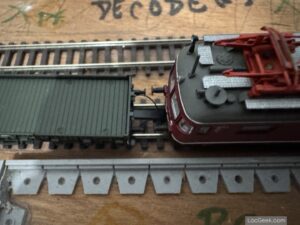I am starting to be very disappointed by expensive models that can’t actually run correctly. The Minitrix Turmtriebwagen TVT 6251 Mz (part no 16992) is one of them
The joy of auto-registration at the command station
I mentionned in my last article that I went back to using my ESU Ecos II as a command station, for its ability to recognise engines (and functions) of both RailCom Plus and M4 (Mfx) engines (Back to the layout and back to the ESU Ecos II).
The great advantage of all recent Minitrix models, is that they are both DCC (without RailCom Plus) and Mfx compatible. This diesel motorized unit is no exception: a minute after being put on the track, the vehicule appears, with all functions properly setup on my Ecos II. Just the picture is missing (which I upload later to the Ecos manually).
That to me is clearly very practical. And even if I were to abandon M4/Mfx (remember M4 is the ESU name for Mfx but is exactly the same), I can still use the train with DCC signals.
Ok model, disappointing technical specs
So the model is a DMU and a trailer car. The trailer car is provided with a lasercut accessory, representing a roll of catenary wire. The problem is, it’s very fragile. My model was delivered with the small work scale already bent.
Sound is loud and clear, with many functions including workers cursing (all in the details). The trailer is attached by a fixed coupling bar, that can sill be unplugged if needed.
Also, there is no driver cab or interior lighting, which seems cheap because thanks to the integrated decoder on the board, there is plenty of room for just adding a few leds.
What was disappointing was the power pickups. The engine kept stopping one in a while, even though my track is relatively clean. After all, it’s 2-axle vehicule in N. We all know this isn’t ideal. Now looking on the inside, presenting a fully integrated decoder on the main board, it seems small capacitors are installed. But not enough.
On that kind of train set, I was expecting the trailer car to also have power pickups, and a conducting magnetic coupling between the two parts. None of this. Plus, what’s weird, is that the coupling on the engine side seems to have a provision for a conducting coupling. This is a method Minitrix uses on its – very similar in size – schienenbus (rail bus) with multiple cars.
Fine, I’ll do it myself
I decided to DIY something better. Magnetic coupling would have been too complicated, because the two cars actually have different coupling heights. I would have had to 3D print special coupling heads.
So I opted for simply attaching the two with discrete wires. Luckily, finding the rail connections on the electronic board of the engine wasn’t too hard, so soldering my extra power pickups would be relatively easy.
On the trailer car side, I installed generic power feeders, so that they provide an additional power point on each side.
After carefully assembling, and finding the right wire lengths and position: voilà ! Finally an engine that runs smoothly. I don’t mind having the trailer car always attached in that case.
Give us something that actually works in real life
This was an expensive sound model. And yet, it could have been better. It seems to me some manufacturers don’t test their models on realistic layouts (points, curves, and clean but not pristine tracks). This was the same (or worse) for the Hobbytrain Railjet cars, that basically would derail all the time because of the couplings…
In any case, still a nice little model. But beware of small engines: without enough power pickups or a very large capacitor on board, getting stuck is pretty much unavoidable.
Reminder: I am a hobbyist and these articles only represent my personal views. I am not receiving any compensation, in any form, from the brands or stores mentioned here. The product names, marketing names, and brands mentioned here are the property of their respective owners.
















